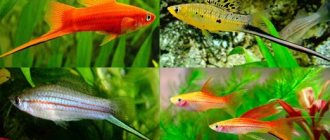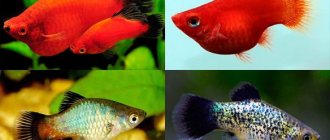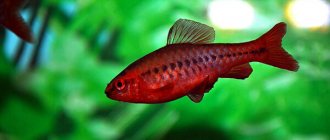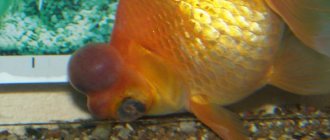Tarakatum – These are one of the most common catfish in our aquariums. Their popularity is due to their unpretentiousness, endurance and peaceful disposition.
Latin name: Hoplosternum thoracatum.
Correct name: Many call this fish t A rakatum, probably comparing it with a cockroach, but it is still correct to say t O rakatum, from the Latin “thorax” - shell.
Synonyms: Torakatum, hoplosternum, catfish thoractum, tarakatum catfish. Family: Armored catfish. Water temperature: 22-28 C. Ph “acidity”: 5.8-7.5. dH: up to 25. Behavior: Peaceful. Content difficulty: Very easy. Compatibility: Virtually any fish - these catfish - do not pose any threat to other inhabitants of the aquarium.
Incompatible: Tarakatums do not get along with aggressive and predatory fish, such as large cichlids. It is not recommended to keep them with labeos and bots , since the latter chase them, which is explained by the struggle for territory. In addition, it is better not to combine cockroaches with fish that are too small; at some point, the catfish may still eat the small fry.
How long do they live: Tarakatums are long-lived in aquariums and can live more than 10 years. You can find out how long other fish live HERE!
Visualization of the thoracatum sausage
Description
The aquarium fish tarakatum (lat. - Hoplosternum thoracatum) is a species of catfish from the family of armored catfish. Habitat: South America. It lives in abundance in the Amazon River and in rivers near the island of Trinidad. It was brought to the USSR in 1971.
It lives in rivers with strong currents and a small amount of oxygen in the water. Because of this, in the process of evolution, a new form of respiration appeared - intestinal respiration. They are able to absorb air through the anus.
Appearance
- Body. The body is long and slightly flattened on the sides, especially in the abdominal area. There are bone plates on the sides. The head is massive with a sharp muzzle. There are two pairs of whiskers near the mouth. One pair is located at the bottom and is intended for feeling the river bottom. Other mustaches are located straight and slightly to the sides. They help to sense currents, water movements and obstacles along the way.
- Color. Color ranges from light brown to dark brown. There are small dark spots on the body, head, and fins. The spots appear in adolescence and from then on remain on the body until the end of life. The abdomen is creamy white or beige in color.
- Length. Typically, catfish have a size of 10–14 cm. But especially large individuals reach a size of 18 cm.
Behavior
The fish is nocturnal and during the daytime it is passive and inactive. It lives in the bottom of rivers and reservoirs, searching for insects and food particles among the sand and stones at the bottom. It shows no interest in other inhabitants unless they invade its bottom territory and attack. Because of this quality, the fish can get along with almost any type of fish in the same aquarium.
Lifespan
In the wild, catfish live 4–6 years, and in an aquarium for more than 10 years.
Habitat in nature
The homeland of the tarakatum catfish is the waters of South America. The fish lives in the rivers of Brazil, Paraguay, Peru, Ecuador and Bolivia. There have also been isolated cases of spotted catfish appearing in water bodies in the United States and on the island of Trinidad. Presumably, they were brought here accidentally by the current of the world's oceans or released by breeders.
Under natural conditions, fish quickly adapt to any habitat, so water hardness, acidity and freshness do not play a big role for them.
Kinds
From the moment the species was discovered until 1997, there was only one species - cockroaches. But in 1997, scientists began to study this species and discovered three more varieties. Each of them had its own characteristics. The albino cockroach is also popular for its white color, which stands out on the bottom of the seabed.
Beige cockroach
In the wild, it lives in the rivers of Ecuador, Argentina, and Colombia. The body size is 15–17 cm, but some individuals grow up to 20–22 cm. There are also bone plates on the sides. The color is pale brown, sometimes tinged with green. The fins are also pale brown in color, with peculiar hooks located at the ends. There are dark spots on the body, fins and head. The abdomen is lighter than the body, colored beige.
Hoplosternum magdalena
Or hoplosternum magdaienae. The fish got its name - magdalena - in honor of its habitat. It was first found in the Magdalena River, located in Colombia. Later, this species was found in the Cauca and Maracaibo rivers. Grows up to 15–16 cm. The color is pale brown with dark spots, the fins are translucent. The rays on the pectoral fins are yellow.
Long-whiskered dianema
Dianema was found in central South America. The color is similar to other species - ranging from pale brown to pale pinkish. There are small black spots on the body. Often there are black stripes on the tail. It differs from other species in its long whiskers, with which it feels the bottom.
Content
Keeping a tarakatum catfish will not cause any particular difficulties. The main requirement is to keep several catfish in the aquarium. These are schooling animals that in nature form groups of 500–1000 fish. If kept alone, your pet will be stressed. To take care of several fish of considerable size, you need a large aquarium volume.
Be sure to equip the aquarium with a tight lid. Tarakatums are able to breathe air. Sometimes, floating to the surface, they do not have time to stop and jump out of the water. The lid will help save your pet's life.
Aquarium
Cockroaches require a large aquarium size. A hundred-liter aquarium with a large bottom area is suitable. You will need an abundance of shelters and decorations - shards, pipes, houses, turrets, thickets of plants.
Water should be replaced weekly by one third of its volume. If the water is too polluted, then by half. Water needs to be enriched with oxygen.
Water parameters
In nature, catfish lived in hot countries with high water temperatures. And provide them with warm water in the aquarium.
- The optimal water temperature is 24–27 degrees.
- Water acidity -5.7–7.6 Ph.
- Water hardness is 20–25 dH.
Plants
Plants are necessary in an aquarium. They will diffuse light and create dark areas that catfish love. Large-leaved plants or duckweed and riccia, which cover the surface, are suitable for the role of plants in the house for catfish. With the second option, make sure that the fish have free access to the surface of the water.
Priming
Choose a substrate for the bottom that is large and smooth. Coarse sand, artificial stones, crushed gravel or pebbles are suitable. Shallow soil is not suitable because catfish will raise turbidity and pollute the water.
Pieces of soil should be free of sharp edges and jagged edges. This will cause damage to the snout and whiskers as the fish digs around among the rocks.
Equipment
In an aquarium with catfish, filtration and aeration are necessary. Fish in nature lived in bodies of water with strong currents and oxygenated water. The filter must create sufficient water flows for catfish. An aeration device (such as a compressor) is important, but catfish have the ability to breathe air, so this is not a major factor for catfish.
Lighting
Catfish do not like bright lighting. Do not place an aquarium with them near a window or directly under a chandelier. Additional lighting in the form of aquarium lamps is not required. Ideally, twilight or weak, diffused light suits them. The aquarium should have dark hiding places.
Feeding
As a large species, cockroaches require a large amount of food and a varied diet.
These fish are able to eat both dry and live food.
- Dry granulated food. It comes in the form of flakes, granules, and tablets. It includes the necessary supplements and vitamins. Granulated food is divided into fry and adult fish, for sick fish, to improve coloration, fortified and others.
- Live food. Catfish eat bloodworms, coretra, crushed earthworms, brine shrimp, krill, and pieces of meat (for example, shrimp).
- Forbs. Some catfish like vegetarian food. They are sometimes given dandelion leaves and lettuce.
Tarakatums eat a lot and have a good appetite. Sometimes they take food from other less active fish. Feed the catfish 2-3 times a day, preferably in the dark, and then the catfish will always be fed and active.
Diseases - prevention and treatment
Tarakatums, like other fish, are prone to dangerous diseases. To minimize the likelihood of serious complications or death, aquarists must be able to recognize the first signs of these pathologies and know how to respond to them.
It is important! Tarakatums are difficult to tolerate drug therapy. Therefore, before giving them medications, it is necessary to consult a specialist.
Ichthyophthiriasis, or “semolina”
A viral disease, the characteristic feature of which is white tubercles, similar to stuck semolina. An infected cockroach becomes lethargic and hangs on its side.
Ichthyophthiriasis is treated with the following drugs:
- Antipar;
- Omnisan;
- Mikopur.
Medicines must be given according to instructions. It is recommended to add Furacilin and Delagil to the water at the rate of 1 tablet per 30 liters.
Fungus
A common disease that develops against a background of weakened immunity. The fungus appears at the site of open wounds and looks like white spots that quickly become overgrown with “cotton wool.” Sick fish become lethargic, breathe heavily and refuse to feed. They are moved into a quarantine aquarium, and a weak solution of potassium permanganate is added to the water.
Furunculosis
Abscesses and spots appear on the scales of an infected cockroach, the abdomen turns red, and signs of necrosis develop on the fins. Furunculosis is transmitted from sick fish to healthy ones. Therefore, before adding a new inhabitant to the aquarium, it is recommended to quarantine him for 10 days.
To treat furunculosis, use Sulfamerazine or Furazolidone tablets. They are given throughout the week 3-4 times a day, mixed into the food.
Mycobacteriosis
Infection occurs through contact with infected feed, vegetation or soil. Mycobacteriosis is manifested by spots on the body, peeling of scales, darkening of the iris and refusal to eat. Recovery is possible only with timely treatment. The therapy involves disinfecting the soil by boiling and treating the aquarium with a 5% bleach solution. Kanamycin is added to the food of sick catfish for 5 days.
Gill plate infection
The disease is transmitted from other fish and through infected food. The gills of the cockroach become covered with red or gray stripes, and then signs of necrosis appear. The catfish loses its appetite, becomes lethargic and practically does not react to external stimuli.
The water in the aquarium is completely replaced, and the sick fish must be placed in a quarantine tank and treated with Acrimet. The drug is given for 5 days at 12-hour intervals.
Compatibility
Catfish get along with almost all species due to their calm and peaceful nature. If the fish do not bother him too much, the catfish will not pay any attention to other inhabitants. But active and aggressive fish will cause stress in the catfish.
Excellent neighbors will be:
- Rainbows.
- Danio.
- Angelfish.
- Goldfish.
- Tetras.
- Rasbory.
Tips for choosing neighbors for catfish:
- Fish with a body length greater than 6–7 cm. Otherwise, the catfish will start chasing them and will later eat them.
- Fish should live at medium depths or near the surface.
- Do not introduce bottom-dwelling fish. The abundance of fish living near the bottom will cause stress and lack of territory for the catfish.
- Do not keep with territorial fish, for example, cichlids, loaches.
in the photo there is a nest of thoracatums
Having built the nest, the male begins to chase the female, at the same time, not forgetting to guard the nest, from time to time completing it, or even rebuilding it in another place. Such manipulations can continue for quite a long time. Sometimes the “games” drag on for as long as a week.
At the end of this “performance”, the female, ready for spawning, swims up to the male from the side and, taking milk into her mouth, rises to the nest, turns over with her belly up and begins to glue the eggs to the leaf of the plant. At one time, the female can spawn from 500 to 1200 eggs. The caviar is yellow-white, large. The spawning process lasts a couple of hours. Afterwards the male closes the nest.
The incubation period of eggs is 10 days. In cockroaches, the male guards the clutch and looks after the offspring.
Reproduction
Breeding cockroaches at home is possible and not too difficult. To breed cockroaches you will need several pairs of fish or one male and several females. Before breeding, the temperature of the water in the aquarium is increased by several degrees.
Before spawning, the male prepares a nesting site. Over the course of several weeks, the male makes a nest from pieces of plant and air bubbles. The bubbles do not break because they are coated with a special substance in the fish's mouth. Large leaves and stems of the plant are used as the frame of the structure.
After building a foam nest, the male begins to court the female. Only a pair in which the partners are both happy with the choice will spawn. If the couple does not work out, then you should not expect offspring. To do this, one male and several females are introduced, and the male makes his choice.
Sex differences
You can distinguish a male from a female by the following criteria:
- Fish size. Female cockroaches are much larger than males.
- Shape, size and color of fins. In an adult male catfish, the fins on the chest have a more geometric shape and resemble a triangle. Females have fins that are more rounded and smaller in size than those of males. In males, the first ray of the pectoral fin is thickened and sharp. During sexual activity, it turns yellow-orange.
- Abdomen color. During spawning, the male's abdomen changes its cream color to blue-violet. The female's abdomen does not change in color, only becomes larger and plumper.
Spawning
Spawning of cockroaches occurs after courtship of a female. The female lays eggs, and the male immediately fertilizes them and carries them to the nest. Capable of laying up to 1000 eggs.
After spawning, all care for the offspring falls on the father. He carefully protects the eggs and returns those that fall out to the nest. Incubation takes 9–11 days. After this, the male is separated from the fry.
Caring for fry
After hatching, the fry feed on microorganisms in the soil. After 2–3 days, they are given crushed earthworms and dry food for the fry. Provide dark places for the fry.
The wisdom of thoracatum spawning
As a spawning aquarium, it is best to use a 100-liter reservoir, which is filled 2/3 with settled water and 1/3 with boiled water. The surface of the water is covered 1/3 with floating plants (can be artificial), and it is under the leaves of these plants that the male will build a nest.
Diseases
Catfish have strong immunity, but some diseases are also found in them.
- Mycobacteriosis. This disease manifests itself in refusal to eat, clouding of the iris, and detachment of scales. The sick individual is treated with Kanamycin. The soil and decorations are disinfected from microbes.
- Furunculosis. With furunculosis, the fin turns black and dies, unhealthy spots and abscesses appear on the scales, and the abdomen turns red. Cured with Furazolidone.
- Infection of the gills. Symptoms – plaque, red stripes, gray spots appear on the gills; the pet is passive and has no appetite. The drug Aktimet helps.
The catfish's whiskers may also fall off. This happens when the soil is chosen incorrectly. The animal gets injured on the sharp corners of the stones and the wounds become infected. Because of this, the tissue in the mustache dies and it falls off.
The photo shows a female Thorakatum
The most difficult thing in breeding cockroaches is selecting producers. They reproduce in pairs. Pairs are formed independently, but taking into account their tastes and preferences. Therefore, it is best to keep cockroaches in a flock, from which breeding pairs can easily form on their own.
Sexual maturity of breeders occurs at 8-15 months. In essence, the breeding process consists of the male constructing a foam nest, similar to the nest of labyrinth fish, laying eggs and then protecting the clutch.
Reviews
Aquarists who have cockroaches in their aquarium speak positively about them. They note calmness and lack of aggression towards other members of the aquarium. Catfish should be the first fish to get, because they are tenacious and unpretentious. They themselves clean the tank of waste and debris. But some are upset that you rarely see them during the day. Most often, these creatures hide in poorly lit places, shelters, and plants.
Photo gallery
Adviсe
Tarakatum catfish are loved by aquarists because of their vitality and endurance, omnivorousness and interesting behavior. They will continue to inhabit aquariums with various inhabitants for a long time.
Previous
Varieties of Cherry barb (veil): maintenance, breeding (reproduction), compatibility, photo, care, description
Next
Varieties of catfish synodontis (changeling): compatibility with other aquarium fish, maintenance, types, reproduction, photos
Great article 0
in the photo there is thoracatum caviar
If necessary, the leaf with eggs can be transferred to another aquarium immediately after spawning, while in the new reservoir weak aeration is installed under the leaf to create a flow of water.
After approximately 7 days, the eggs hatch into viable larvae. Having fallen to the bottom, they immediately begin to look for food.
in the photo is a cockroach larva
Starter food: live dust, finely chopped tubifex, other finely ground dry food.
After a week, the fry reach a length of 1 cm. During this period, it is very important to monitor the quality of the aquarium water - change it daily to ? old water to fresh, settled water.
Tarakatum photo
The most important thing in keeping any fish is that there are no excessive concentrations of nitrogen compounds and phosphates . This is the main problem for fish that beginners make. Ammonia, nitrite, nitrate, phosphates are the root cause of illness and death in pets. Every conscientious aquarist should always have a set of drop tests on hand, at least for nitrate and phosphate. Fortunately, they have now become inexpensive, there are no problems with their assortment and acquisition. For example, we can with a clear conscience recommend you the cool UHE drop tests, , but they are sold only online. In stores in your city - offline, you can find inexpensive Vladox tests .
Tarakatum
When changing water, it would be useful to use clean water supply and use preparations that neutralize harmful substances. For example, Tetra AquaSafe - it removes chlorine compounds, heavy metals + contains B vitamins, iodine and other aquarium goodies. Those. With it, you can safely pour water into the aquarium without fear of harming your beloved pets.











